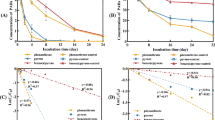Abstract
Degradation of styrene in the gaseous phase was investigated for white-rot fungi Pleurotus ostreatus (two strains), Trametes versicolor, Bjerkandera adusta and Phanerochaete chrysosporium. Fungi were grown in liquid culture and the gas/mycelium contact surface was enhanced with the help of perlite. The influence of various inducers on styrene degradation was studied. The best inducers for styrene degradation were lignosulphonate for P. ostreatus and T. versicolor and wood meal for B. adusta and P. chrysosoporium. Under these conditions all fungi were able to degrade styrene almost completely in 48 h at a concentration of 44 μmol/250 ml total culture volume; one strain of P. ostreatus was able to remove 88 μmol styrene under these conditions. Three transformation products of [14C]styrene in cultures of P. ostreatus were identified: phenyl-1,2-ethanediol, 2-phenylethanol and benzoic acid; 4% of the styrene was metabolised to CO2 in 24 h and no other volatile products were found.
Similar content being viewed by others
Author information
Authors and Affiliations
Additional information
Received: 16 July 1996 / Received revision: 23 September 1996 / Accepted: 29 September 1996
Rights and permissions
About this article
Cite this article
Braun-Lüllemann, A., Majcherczyk, A. & Hüttermann, A. Degradation of styrene by white-rot fungi. Appl Microbiol Biotechnol 47, 150–155 (1997). https://doi.org/10.1007/s002530050904
Issue Date:
DOI: https://doi.org/10.1007/s002530050904




